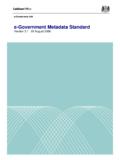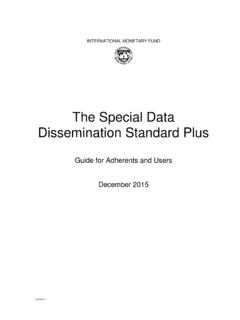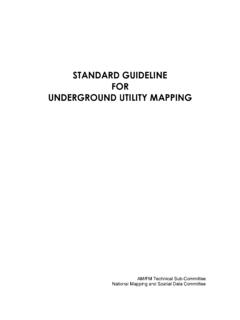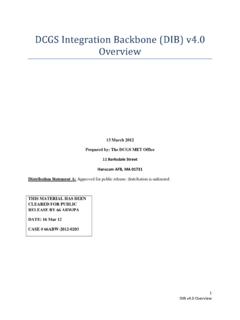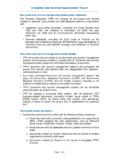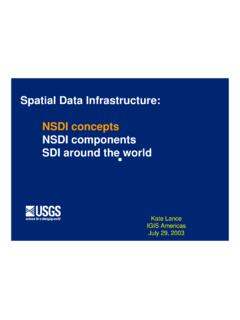Transcription of Part 1 – Reference Description - AGLS Metadata …
1 AGLS Metadata Standard part 1 Reference Description Version July 2010 NATIONAL ARCHIVES OF AUSTRALIA 2 Version of this manual was prepared by the National Archives of Australia during 2010. This most recent version of this document is available from the AGLS website ( ) Copyright Commonwealth of Australia 2010 Portions of this document are Copyright Dublin Core Metadata Initiative 2008 ( ) This work is copyright. Apart from any use as permitted under the Copyright Act 1968 no part may be reproduced by any process without prior written permission from the National Archives of Australia.
2 Requests and inquiries concerning reproduction and rights should be directed to the Publications Manager, National Archives of Australia, PO Box 7425, Canberra Business Centre ACT 2610. 3 PREFACE The information in this two- part Standard was originally adapted from the Australian government Locator Service (AGLS) Metadata standard prepared by the AGLS Working Group for use in government agencies. The National Archives of Australia made the AGLS Metadata element set available on its website in 1998. The members of the IT-021 Committee, Records Management decided to expand it to cover non- government sectors and published as an Australian Standard, and invited the AGLS Working Group to become a subcommittee of IT-021.
3 standards Australia published the Standard in 2002 and renamed it the AGLS Metadata Element Set. Omitting the word government from the title reflected that, with this version of the Standard, the audience was no longer limited to the public sector. This revision is renamed the AGLS Metadata Standard. It was reissued as AS 5044-2010 on 30 June 2010. It takes into account changes introduced by the Dublin Core Metadata Initiative (DCMI) in January 2008 in support of automated processes for identifying and interpreting the meanings implied in natural language (known as semantic inferencing ).
4 This AGLS Metadata Standard provides a set of Metadata properties and associated usage guidelines to improve the visibility, manageability and interoperability of online information and services. The major changes are (a) revising terminology, property descriptions and recommended formatting to remain consistent with the Dublin Core Metadata Initiative (DCMI); (b) assigning free standing descriptive labels to Metadata terms; (c) a clear distinction between Vocabulary Encoding Schemes and Syntax Encoding Schemes; (d) including a DCMI property not previously in the AGLS standard (conformsTo); (e) including four new DCMI properties (accessRights, dateCopyrighted, rightsHolder and license).
5 (f) introducing two new AGLS properties (dateLicensed and protectiveMarking); (g) introducing three additional sets of terms (Agent Metadata terms, Availability Metadata terms and Administrative Metadata terms); (h) deprecation of one element refinement from the previous standard ( ); (i) changes to the obligation status of some properties; (j) including a new obligation status Recommended ; (k) updating references to the most recent versions of Request for Comment (RFC) standards and ISO standards ; (l) examples in eXtensible Hypertext Markup Language (XHTML); and (m) expanding the AGLS Audience Vocabulary Encoding Scheme.
6 Some minor changes have been included since the publication of AS 5044-2010. This does not affect conformance with the Australian Standard. The changes are: (n) RFC 5646 supersedes RFC 4646; (o) Additional AGLS Document vocabulary terms; and (p) Minor change in definition of AGLS Audience term low income earners . This Standard uses the term informative to define the application of the appendix to which it applies. An informative appendix is only for information and guidance. 4 CONTENTS PREFACE .. 4 1 SCOPE .. 7 2 REFERENCED 3 TERMINOLOGY.
7 8 4 DEFINITIONS .. 8 5 10 6 AGLS Metadata TERMS .. 13 7 AGENT Metadata TERMS .. 29 8 AVAILABILITY Metadata 32 9 ADMINISTRATIVE Metadata 37 10 TERMS IN LEGACY 39 11 VOCABULARY ENCODING 43 12 SYNTAX ENCODING 47 13 50 14 TERMS RELATED TO THE DCMI ABSTRACT MODEL .. 55 APPENDIX A: INDEX OF 56 APPENDIX B: FURTHER READING .. 58 APPENDIX C: AGLS MAINTENANCE 58 5 AGLS Metadata Standard part 1: Reference Description July 2010 FOREWORD Development History The AGLS Metadata Standard (formerly known as the Australian government Locator Service and the AGLS Metadata Element Set) had its origins in the work of the Information Management Steering Committee (IMSC), an interdepartmental committee established by the then Commonwealth Office of government Information Technology (OGIT).
8 The then Chief government Information Officer, Andy McDonald, established the IMSC in 1996. Chaired by the then Deputy Director-General of the National Library, Eric Wainwright, the Committee released its report, The Management of government Information as a National Strategic Resource, in August 1997. This report proposed frameworks for government information policy and the deployment of associated technology into the 21st century. Development of the AGLS element set began in December 1997 with an invitational workshop held at the National Archives of Australia. The workshop brought together representatives of federal and state/territory government agencies, other interested parties such as the Federal Libraries Information Network, and the academic research community.
9 The development objective was to produce a set of Metadata elements which would improve the visibility, availability and interoperability of government information and services through the provision of standardised web-based resource descriptions which enable users to locate the information or service that they require. From 1998, the use of AGLS spread beyond the public sector for which the standard was originally developed. The use of AGLS by various cross-sectoral web portal initiatives accelerated this process. In recognition of the wide potential adoption of AGLS within Australia, standards Australia decided to adapt and issue AGLS as an Australian Standard.
10 standards Australia first issued the Standard in 2002, incorporating a set of 19 elements. Since 1998, notions of best practice in the Semantic Web have evolved to include the assignment of formal domains and ranges in addition to definitions in natural language. Domains and ranges specify what kind of described resources and value resources are associated with a given property. These relationships can be used to support automated processes for identifying and interpreting the meanings implied in natural language (known as semantic inferencing ). The current version of the Standard takes into account changes introduced by the Dublin Core Metadata Initiative (DCMI) in January 2008.
